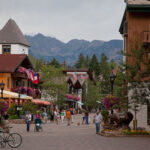Here in Pueblo county is the battle site of Cuerno Verde . In 1777, Teodoro del Croix, Commander General of the Internal Provinces, appointed de Anza Governor of New Mexico in hopes that he could do something about the Comanche problem.
Upon his arrival in Nuevo Mexico, de Anza quickly determined that previous forays against the Comanche all failed for the same reason: the Spaniards always took the same route east over the Sangre de Cristo’s and then north over the Ratons. The Comanches saw them coming and just retreated to wait for a better day. De Anza determined to use a completely different route to the plains of Colorado, to sneak up on the Comanches.
He left Santa Fe with some 600 men: soldiers, settlers and allied Pueblo Indians. De Anza mustered his force at San Juan de los Caballeros, near the junction of the Chama and Rio Grande rivers. He then marched north at night along the western edge of the San Luis Valley over Poncha Pass, across South Park, then east to Ute Pass (north of Pike’s Peak).
De Anza’s scouts reported an encampment of Comanches on the plains near today’s Wigwam, Colorado (south of Colorado Springs). He attacked them immediately, successfully. However, Cuerno Verde and his warriors were absent on a raid against Taos. So de Anza and his men hurried south along an ancient trail later known as the Trapper’s Trail, (This is the trail that runs near my home that I spoke of above), to the area we know now as Pueblo. From there they headed down the flank of the Wet Mountains (Sierra Mojada) heading for Sangre de Cristo Pass.
Somewhere just east of Greenhorn Mountain the Spaniards met up with Cuerno Verde’s raiders returning from their unsuccessful raid on Taos. The two groups skirmished a bit, then separated and regrouped. The next day the Comanches came up very close against the Spaniards and fired their muskets. The Spaniards identified Cuerno Verde by his headdress and cut off him and his closest warriors, trapping them in a gully. Cuerno Verde dismounted and, from behind his fallen horse, made his final defiance of the Spaniards. A hail of lead balls claimed his life and those of his followers. When it was all over, the Spaniards scoured the field for useful items and de Anza claimed the distinctive headdress as proof of his endeavors. He forwarded the headdress to Teodoro del Croix, who, rumor has it, forwarded it to his superiors who forwarded it all the way to the Vatican.
De Anza finally made a lasting Spanish-Comanche peace in 1787. That cleared the way for the Arapaho and the Cheyenne to move onto the plains and trade peacefully with the Spanish comancheros and ciboleros riding out of Santa Fe and Taos.
What’s left of Cuerno Verde adorns a mountain: Greenhorn Mountain, and a valley: Greenhorn Valley. Neither signifies the location of the battle in which the Comanche chief fell.
When you are up on Greenhorn Mountain, on a calm quite day, you can hear voices whispering in both Spanish and Comanche. You can also sometimes feel a very strong presence, when no one else is around.
Over off of Pueblo Boulevard is the Nature Trail. It runs alongside the Arkansas River. People usually only walk this trail alone, at night, once. IF they walk it again, they always make sure to have someone with them. Why? You ask. Because walking this trail you never are really alone. You feel as if someone is following you, even to the point of hearing their footsteps, yet no one is ever there when you turn to look.
There are also stories of drowning in the river, and so is it any wonder that you might have a little company on your walk? Most people won’t walk the trail after dark, and if they do, they always make sure they have someone with them.



